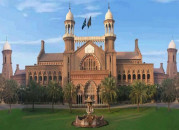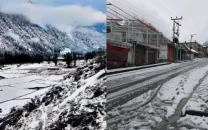The debt spiral
Government borrows money to pay for oil import, or portions of circular debt, its paying for yesterday’s consumption.

It was difficult to watch the debt ceiling drama unfold without casting an eye on our own debt situation at home. Could our rising levels of domestic debt create a crisis-like situation for us? The simple answer is yes, of course. But what will this crisis look like, how will it play itself out? Is it possible to calculate the point past which our rising debt and its attendant obligations will carry us into the crisis zone? No simple answers here.
To get a stock of the situation regarding our steeply rising domestic debt, consider some basic numbers. The government is set to run a deficit of one trillion rupees in the current fiscal year. How will it bridge the gap between revenues and expenditures? External inflows have not been more than 50 per cent of what was ‘projected’ — hoped for is a better term — in the past four to five years.
Outsiders are losing the stomach, the appetite, the will to keep paying for our follies. And why shouldn’t they? We’ve shown no inclination to help ourselves by raising revenues or cutting wasteful spending.
Without external support, the government must turn to domestic sources of financing for the deficit. Top amongst these are the banks. But there are two problems when the government borrows from the banks to pay for its current spending.
The first problem is this: The money in the banks represents our national savings and is meant to be used to pay for investment which will yield future growth. In short, bank money is meant to pay for future consumption. When the government lifts this money to pay its bills, it is diverting money meant for future investment to pay for present-day consumption. Even worse, where the money is used to pay for oil import bills, or to pay portions of the circular debt, it is in fact being used to pay for yesterday’s consumption.
In agricultural terms, this is called ‘eating your seed corn’. It is as if a family pulled its children out of school and took the resultant savings and paid its present-day bills with the money. What will that family do when the children grow up, and the meagre income streams they are living on begin to shrivel up as all income streams do over a period of time, unless renewed?
But let’s leave aside questions related to the distant future for now. There is a more immediate problem posed by the rising levels of domestic debt. There simply isn’t enough money in the banks to pay for the government’s annual expenditures.
Bank deposits tend to grow by around 10 per cent every year, the natural rate of growth of our money supply. Out of this growth, banks pay anywhere from six to eight per cent as returns to the depositors, leaving the rest available as liquidity to be loaned out. Net increase of money available to be lent is, therefore, no more than five and a half per cent or so. If we assume that all of what is left after paying the depositors their return will be lifted by the government, we’re left with about Rs550 billion rupees or so available to be lent, according to some estimates from the State Bank. That still leaves us with a hole just under half a trillion rupees to fill.
Where will this money come from? We have yet to receive a straight answer from our finance ministry to this question. Without external inflows, without new revenue streams, there is only one source left: Printing.
So this is where we find ourselves today, as the world struggles with the implications of stupendously high sovereign debt levels. We have a situation where the government is consuming the country’s ‘seed corn’ to pay for current consumption, and capping off the remainder through printing of notes. The spiral of debt has found its way to our jugular as well.
How do you end this situation, which is taking us towards catastrophe? There are only three ways. First, pray hard for a bailout. Second, yell hard for tax reforms, which have died conclusively. Third, brace for catastrophe: Spiralling inflation and a banking crisis.
It’s not hard to see how increasing debt without similarly rising revenues takes you towards a banking crisis. Since most of the government debt held by the banks is in the form of treasury bills of very short tenor, any interruption or rescheduling of any sort on its payment obligations or difficulties in rolling over maturing debt will directly hit bank balance sheets in a devastating blow.
Secondary markets for T-bills will dry up, lending will seize, and banks will start hoarding liquidity. Then will come the runs on the smaller banks, sparking a panic. Nobody can say how the situation will play out after that. We don’t have deposit insurance in Pakistan, nor do we have the fiscal wherewithal to arrange a government bailout. We’ve never been in this situation before, our banks have been government owned for the past four decades at least. How will a privately owned banking system, marked by high levels of credit concentration and steep exposure to government paper, react to sovereign debt service difficulties? Nobody knows. The situation has no precedent in our history in the last few decades.
If the brakes are not applied to the growing domestic debt, our banks will be exposed to a potential systemic crisis the likes of which was only narrowly averted in the fall of 2008. America has an excuse for its financial woes. After all, it is a superpower with planetary obligations. But what is our excuse?
Published in The Express Tribune, August 4th, 2011.



















COMMENTS
Comments are moderated and generally will be posted if they are on-topic and not abusive.
For more information, please see our Comments FAQ